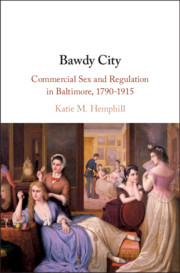Book contents
- Bawdy City
- Bawdy City
- Copyright page
- Dedication
- Contents
- Figures
- Acknowledgments
- Abbreviations
- Introduction
- Part I The Rise of Prostitution in the Early Republic
- Part II Regulating and Policing the Sex Trade
- 4 Policing the Expanding Sex Trade
- 5 “Our Patriotic Friends”
- 6 Prostitution, Policing, and Property Rights in the Gilded Age
- Part III Change and Decline in the Brothel Trade
- Conclusion
- Bibliography
- Index
4 - Policing the Expanding Sex Trade
from Part II - Regulating and Policing the Sex Trade
Published online by Cambridge University Press: 06 December 2019
- Bawdy City
- Bawdy City
- Copyright page
- Dedication
- Contents
- Figures
- Acknowledgments
- Abbreviations
- Introduction
- Part I The Rise of Prostitution in the Early Republic
- Part II Regulating and Policing the Sex Trade
- 4 Policing the Expanding Sex Trade
- 5 “Our Patriotic Friends”
- 6 Prostitution, Policing, and Property Rights in the Gilded Age
- Part III Change and Decline in the Brothel Trade
- Conclusion
- Bibliography
- Index
Summary
This chapter traces efforts by Baltimore and its courts to grapple with the expanding prostitution trade in the decades before the Civil War. Initially, local officials and courts attempted to take a suppressive approach to prostitution, in keeping with long-standing common-law precedents that enabled the state to police urban disorder. However, efforts at suppression proved prohibitively taxing on city resources, which prompted the adoption of a bifurcated approach to commercial sex in which the local officials and magistrates continued to punish public prostitution while largely tolerating indoor prostitution. By the 1840s, Baltimore had developed a regulatory approach to the sex trade that was intended to ensure that it remained as contained and orderly as possible. This system continued to function for nearly two decades before a groundbreaking 1857 legal intervention allowed city residents to seek equitable remedies for the presence of brothels in their neighborhoods. The precedent set in Hamilton v. Whitridge would set the stage for the containment of brothels within red-light districts, although it would take the Civil War to usher in that new phase of spatial regulation.
- Type
- Chapter
- Information
- Bawdy CityCommercial Sex and Regulation in Baltimore, 1790–1915, pp. 111 - 145Publisher: Cambridge University PressPrint publication year: 2020



